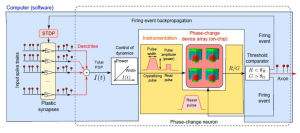
IBM Research in Zurich has created the world's first artificial nanoscale stochastic phase-change neurons. IBM has already created a population of 500 of these artificial neurons and used them to process a signal in a brain-like (neuromorphic) way.
This breakthrough is particularly notable because the phase-change neurons are fashioned out of well-understood materials that can scale down to a few nanometres, and because they are capable of firing at high speed but with low energy requirements. Also important is the neurons' stochasticity—that is, their ability to always produce slightly different, random results, like biological neurons.
Enough fluff—let's talk about how these phase-change neurons are actually constructed. At this point, it might help if you look at the first diagram in the gallery.
-
A diagram showing a single phase-change neuron.IBM
-
The dynamics of a phase-change neuron. Bottom left shows the gradual crystallisation of the GST - when there's enough crystalline (shown in blue), the neuron fires.IBM
-
On the left you can see a single phase-change neuron's behaviour initially - in the middle, you can see how it behaves after a few seconds.IBM
Like a biological neuron, IBM's artificial neuron has inputs (dendrites), a neuronal membrane (lipid bilayer) around the spike generator (soma, nucleus), and an output (axon). There's also a back-propagation link from the spike generator back to the inputs, to reinforce the strength of some input spikes.
The key difference is in the neuronal membrane. In a real neuron, this would be a lipid bilayer, which essentially acts as both a resistor and a capacitor: it resists conductance, but eventually, with enough electricity along the input dendrite, it builds up enough potential that its own spike of electricity is produced—which then flows along the axons to other neurons—and so on and on.
In IBM's neuron, the membrane is replaced with a small square of germanium-antimony-tellurium (GeSbTe or GST). GST, which happens to be the main active ingredient in rewritable optical discs, is a phase-change material. This means it can happily exist in two different phases (in this case crystalline and amorphous), and easily switch between the two, usually by applying heat (by way of laser or electricity). A phase-change material has very different physical properties depending on which phase it's in: in the case of GST, its amorphous phase is an electrical insulator, while the crystalline phase conducts.
With the artificial neurons, the square of GST begins life in its amorphous phase. Then, as spikes arrive from the inputs, the GST slowly begins to crystallise. Eventually, the GST crystallises enough that it becomes conductive—and voilà, electricity flows across the membrane and creates a spike. After an arbitrary refractory period (a resting period where something isn't responsive to stimuli), the GST is reset back to its amorphous phase and the process begins again.
"Stochastic" refers to a system where there is an amount of randomness in the results. Biological neurons are stochastic due to a range of different noises (ionic conductance, thermal, background). IBM says that its artificial neurons exhibit similar stochastic behaviour because the amorphous state of each GST cell is always slightly different after each reset, which in turn causes the crystallisation process to be different. Thus, the engineers never quite know exactly when each artificial neuron will fire.

Phew, you made it. Now what?
There seem to be two main takeaways here. First, the artificial neurons are made from well-understood materials that have good performance characteristics, last a long time (trillions of switching cycles), and can be fabricated/integrated on leading-edge nodes (the chip pictured above was fabbed at 90nm, but the research paper mentions the possibility of 14nm). The phase-change devices presented in this research are already pretty small—squares that are about 100 nanometres across.

Second, these phase-change neurons are the closest we've come to creating artificial devices that behave like biological neurons, perhaps leading us towards efficient, massively parallel computer designs that apply neuromorphic approaches to decision-making and processing sensory information. IBM says that their new work is complementary to research being carried out into memristor-based synapses, too.
So far, IBM has built 10x10 crossbar arrays of neurons, connected five of those arrays together to create neuronal populations of up to 500 neurons, and then processed broadband signals in a novel, brain-like way. (In technical terms, the neurons showed the same "population coding" that emerges in biological neurons, and the signal processing circumvented the Nyquist-Shannon sampling theorem).
There's no reason to stop there, though. Now it's time put thousands of these phase-change neurons onto a single chip—and then the difficult bit: writing some software that actually makes use of the chip's neuromorphosity.
Nature Nanotechnology, 2016. DOI: 10.1038/nnano.2016.70 (About DOIs).
Listing image by IBM
reader comments
109